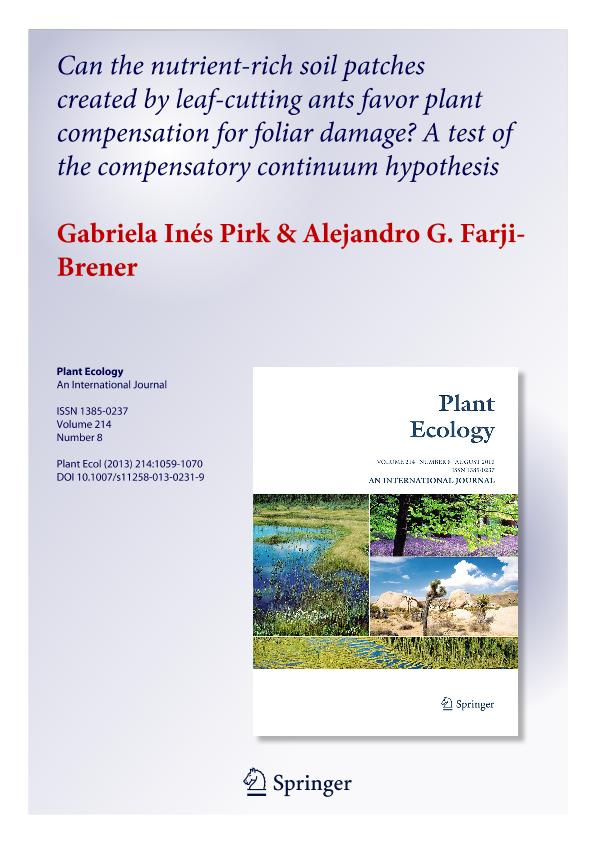Mostrar el registro sencillo del ítem
dc.contributor.author
Pirk, Gabriela Inés

dc.contributor.author
Farji Brener, Alejandro Gustavo

dc.date.available
2016-07-22T20:38:26Z
dc.date.issued
2013-08
dc.identifier.citation
Pirk, Gabriela Inés; Farji Brener, Alejandro Gustavo; Can the nutrient-rich soil patches created by leaf-cutting ants favor plant compensation for foliar damage? A test of the compensatory continuum hypothesis; Springer; Plant Ecology; 214; 8; 8-2013; 1059-1070
dc.identifier.issn
1385-0237
dc.identifier.uri
http://hdl.handle.net/11336/6665
dc.description.abstract
Compensation, the degree of plant recovery after herbivory, is influenced by nutrient availability. The compensatory continuum hypothesis (CCH) predicts that the more abundant the resources in an environment, the greater the potential for compensation. Nutrient-rich patches generated by leaf-cutting ants near their nests could modify plants’ responses to damage. We performed a greenhouse and a field experiment to evaluate the effects of refuse dumps (RDs) created by Acromyrmex lobicornis on plant compensation for foliar herbivory in roadside areas of the Patagonian steppe. We expected higher tolerance in plants growing in RDs than in adjacent non-nest soils (NNSs). We also assessed whether compensation differed between native and exotic species common in the area. We expected higher compensation in exotic than native plants since they perform better in RDs. Native and exotic plants fully compensated for simulated herbivory resembling natural levels. In the greenhouse, clipped plants achieved similar biomass as control plants and in the field reproductive output was similar between treatments. However, compensation was not higher in RDs than NNSs or in exotic than native plants as expected. Both native and exotic plants in roadside areas may have traits associated with disturbance which allow them to tolerate natural occurring herbivory without compromising their performance. Our study, the first one to test the CCH on RDs, shows that enhanced levels of resources do not always determine higher tolerance to herbivory.
dc.format
application/pdf
dc.language.iso
eng
dc.publisher
Springer

dc.rights
info:eu-repo/semantics/openAccess
dc.rights.uri
https://creativecommons.org/licenses/by-nc-sa/2.5/ar/
dc.subject
Acromyrmex Lobicornis
dc.subject
Disturbance
dc.subject
Herbivory
dc.subject.classification
Ecología

dc.subject.classification
Ciencias Biológicas

dc.subject.classification
CIENCIAS NATURALES Y EXACTAS

dc.title
Can the nutrient-rich soil patches created by leaf-cutting ants favor plant compensation for foliar damage? A test of the compensatory continuum hypothesis
dc.type
info:eu-repo/semantics/article
dc.type
info:ar-repo/semantics/artículo
dc.type
info:eu-repo/semantics/publishedVersion
dc.date.updated
2016-07-22T18:52:24Z
dc.journal.volume
214
dc.journal.number
8
dc.journal.pagination
1059-1070
dc.journal.pais
Alemania

dc.journal.ciudad
Berlin
dc.description.fil
Fil: Pirk, Gabriela Inés. Consejo Nacional de Investigaciones Científicas y Técnicas. Centro Científico Tecnológico Patagonia Norte. Instituto de Investigación en Biodiversidad y Medioambiente; Argentina
dc.description.fil
Fil: Farji Brener, Alejandro Gustavo. Consejo Nacional de Investigaciones Científicas y Técnicas. Centro Científico Tecnológico Patagonia Norte. Instituto de Investigación en Biodiversidad y Medioambiente; Argentina
dc.journal.title
Plant Ecology

dc.relation.alternativeid
info:eu-repo/semantics/altIdentifier/url/http://link.springer.com/article/10.1007%2Fs11258-013-0231-9
dc.relation.alternativeid
info:eu-repo/semantics/altIdentifier/doi/http://dx.doi.org/10.1007/s11258-013-0231-9
dc.relation.alternativeid
info:eu-repo/semantics/altIdentifier/doi/10.1007/s11258-013-0231-9
Archivos asociados
